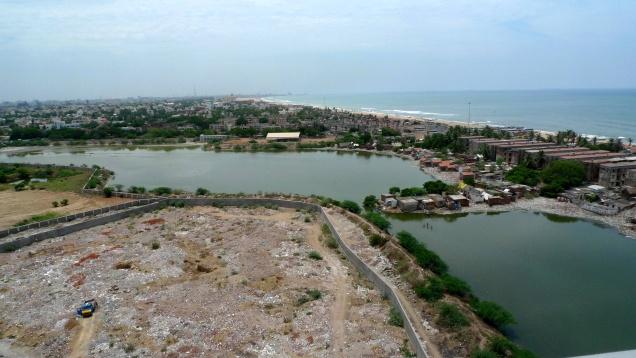NEW DELHI, Apr 21, 2011 (IPS) - Will India, the world’s biggest manufacturer of the pesticide endosulfan, and also the biggest victim of the toxic pesticide, persist with opposing its ban globally?
A coalition of health and environmental activists fears that the central government is preparing to oppose a ban at the Apr. 25 -29 fifth conference of the parties (CoP) to the Stockholm Convention on persistent organic pollutants, or ‘POPs Treaty’, in Geneva.
"We understand that the central government will continue to support endosulfan use, although India risks being isolated in Geneva," said Ravi Agarwal, director of Toxics Link, a participating member of the International POPs Elimination Network.
At the last review committee of the POPs Treaty in October 2010, that had recommended a ban on endosulfan, India forced a vote and then became the only country that voted against it.
But the 172 countries that have ratified the POPs Treaty, in force since May 17, 2004, can push for a ban at the CoP in Geneva, though countries like China, which abstained, and others may oppose it at the forum.
India signed the POPs treaty under the United Nations on May 14, 2002, and ratified it on Jan. 13, 2006. The POPs treaty has helped classify chemicals which are toxic for the environment and to human health.
To attract a ban under the POPs Treaty a chemical has to be persistent, bio-accumulative and a risk to human health - all of which have been scientifically proved in the case of endosulfan.
Independent studies in several countries, including one carried out by India’s National Institute of Occupational Health (NIOH), have linked the chemical to seizures and deaths. Long-term effects of low-dose exposure have been linked to autism, delayed puberty and birth defects.
Agarwal told IPS that the central government’s attitude was "unfortunate", considering that two Indian states, southern Kerala and Karnataka, have already banned endosulfan.
Separately, he said, the National Human Rights Commission (NHRC), a statutory body, had on Dec. 31, 2010 recommended a ban on endosulfan saying that the stand of the central government had led to grave violations of human rights.
"Since endosulfan is a POP, the dangers it poses will linger and multiply through the generations, causing harm on a scale that cannot presently be quantified," the NHRC said.
The NHRC had earlier been informed by the central government that it did not believe that endosulfan was harmful, and had, therefore, opposed its listing under Annexe A chemicals of the POPs Treaty that are fit to be eliminated.
NHRC said it could not understand the logic of the Indian government when "the countries that have banned endosulfan are those that have access to the most advanced scientific research and include the United States, the European Union, Japan, the Republic of Korea, Australia and New Zealand, that have taken their decision on the basis of scientific data and studies."
NHRC categorically asked the central government to "join the international consensus at the next meeting in April 2011 of the state parties of the Stockholm Convention and permit the listing of endosulfan as an Annexe A chemical."
Already 81 countries have either banned or decided to phase out endosulfan, though 27 countries continue to use it. Many of them like the Philippines face local demands for its ban.
Brazil, China, and India are major agricultural countries where the use of endosulfan continues to be legal. Brazil, however, has announced that it will be phasing out the chemical.
Endosulfan is also currently under consideration as an addition to another international treaty, the Rotterdam Convention, which requires government-to-government notification when dangerous pesticides and other chemicals cross international borders.
India produces about 10,500 tonnes of endosulfan annually and exports about 50 percent of it, with the manufacturers successfully lobbying the government to oppose moves for a global ban.
The pesticide, sprayed on crops by aircraft or manually, is popular for its cheapness with farmers who grow cotton, cashew, potatoes, coffee and soybeans.
Endosulfan not only kills such insect pests as whiteflys, aphids, leafhoppers, potato beetles and cabbage worms, but also agricultural workers. The Kerala government acknowledges that several hundred of its workers may have died of endosulfan toxicity.
Various abnormalities have also been found among the population near the estates of the state-owned Plantation Corporation of Kerala, where aerial spraying of endosulfan was conducted for more than two decades.
Health surveys have identified at least 4,000 victims in the Kasaragod district of Kerala, with more than 2,500 of them chronically ill or maimed.
Against such evidence the Pesticide Manufacturers and Formulators Association of India (PMFAI) has been conducting a counter-campaign, planting ‘scientific’ reports in newspapers to question the findings of the NIOH.
India exports about 40 million dollars worth of endosulfan annually, or about 70 percent of the world trade in the chemical.
Agarwal says the money involved is trivial compared to the price paid in terms of public health. He says many alternatives are available.
"It is for the government to put public health before profits for the pesticides industry," said Dr. Mira Shiva, a respected physician, who represents the Initiative for Health and Equity in Society and the All- India Drug Action Network.
Shiva said the evidence from Kerala and Karnataka on the dangers to human health caused by endosulphan was overwhelming and that the government should have honoured the NIOH study rather than "succumb to pressure from corporate interests."
Gopal Krishna, convenor of the Toxics Watch Alliance, a major campaigner, said the non-seriousness of the government towards the POPs Treaty can be seen from the fact that it missed the Dec. 4, 2008 deadline for transmission of its National Implementation Plan (NIP) to the POPs secretariat.
The draft of the NIP was available for public comment until l April 1, 2011.














